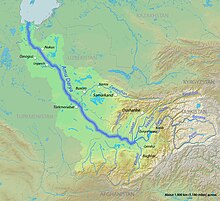| Battle of Oxus River | |||||||||
|---|---|---|---|---|---|---|---|---|---|
| Part of the Muslim conquest of Persia | |||||||||
 Map of Oxus River (Amu Darya) | |||||||||
| |||||||||
| Belligerents | |||||||||
|
Sassanian Empire Göktürk Khaganate | Rashidun Caliphate | ||||||||
| Commanders and leaders | |||||||||
|
Yazdegerd III X Khan of Farghana | Ahnaf ibn Qais | ||||||||
| Strength | |||||||||
| 50,000 | 20,000 | ||||||||
| Casualties and losses | |||||||||
| Unknown; Probably heavier | Lighter | ||||||||
| Muslim conquest of Persia | |
|---|---|
Mesopotamia
Central Persia Caucasus Other geographies |
The Battle of Oxus River was a significant battle in the 7th century, fought between the combined armies of the Sassanid and Göktürk Empires against the Muslim Arab army that had overrun Persia. Following his defeat, the last Sassanid Emperor, Yazdegerd III, became a hunted fugitive who fled to Central Asia and then to China.
Prelude
Khorasan was the second largest province of the Sassanid Persian Empire. It stretched from what is now north-eastern Iran, Afghanistan and Turkmenistan. Its capital was Balkh, now in northern Afghanistan. In 651, the mission of conquering Khurasan was assigned to Ahnaf ibn Qais and Abdullah ibn Aamir. Abdullah marched from Fars and took a short and less frequent route via Rayy. Ahnaf then marched north direct to Merv, in present Turkmenistan. Merv was the capital of Khurasan and here Yazdegerd III held his court. On hearing of the Muslim advance, Yazdegerd III left for Balkh. No resistance was offered at Merv, and the Muslims occupied the capital of Khurasan without a fight.
Battle
Ahnaf stayed at Merv and waited for reinforcement from Kufa. Yazdegerd proceeded to Soghd whose ruler supplied him with a large army. The Khaqan of Turks after assembling the troops from Ferghana, crossed the Oxus along with Yazdegerd and marched to Balkh. Ribi' b. Amir meanwhile retired with Kufan troops to Marw al-Rudh where he joined al-Ahnaf. The Sasanian king and the Khakan leading an army of 50,000 cavalry composed of men from Soghd, Turkestan, Balkh and Tokharistan, arrived at Marw al-Rudh. Ahnaf had an army of 20,000 men. The two sides fought each other from morning till evening for two months at a place called Deir al-Ahnaf. The fighting at Deir al-Ahnaf went on until Ahnaf, after being informed of a Turkic chief inspecting the outposts, went there during a particular night and successively killed three Turkic chiefs during their inspection. After learning of their deaths, the Khakan became afflicted by it and withdrew to Balkh, then he withdrew across the river to Turkestan. Yazdegerd meanwhile left from Marw al-Rudh to Merv, from where he took his empire's wealth and proceeded to Balkh to join the Khakan. He told his officials that he wanted to hand himself to the protection of the Turks, but they advised him against it and asked him to seek protection from the Arabs which he refused. He left for Turkestan while his officials took away his treasures and gave them to Ahnaf, submitting to the Arabs and being allowed to go back to their respective homes.
Aftermath
After being defeated at the Battle of Oxus river, Yazdegerd III was unable to raise another army and became a hunted fugitive. Following the battle, he fled to Central Asia to the court of the Khan of Farghana. From there, Yazdegerd went to China. Nevertheless, Yazdegerd III kept on intruding in Persia, using his influence over the notables and chiefs of Persia, thus remained a motivating force behind the Persian rebellion. During Caliph Uthman's reign, Yazdegerd III came back to Bactria and Khorasan rebelled against the Caliphate. Abdullah ibn Aamir crushed the rebellion and defeated Yazdegerd's forces. He fled from one district to another until a local miller killed him for his purse at Merv in 651.
See also
Notes
- ^ "Iran". Encyclopædia Britannica. Archived from the original on 2013-08-13. Retrieved 2009-04-24.
- ^ The Journal, Volume 11. Asiatic Society of Bombay. 1969. pp. 213, 214.
- The Muslim Conquest of Persia By A.I. Akram. Ch:17 ISBN 0-19-597713-0,
- ^ Shadows in the Desert: Ancient Persia at War, By Kaveh Farrokh, Published by Osprey Publishing, 2007 ISBN 1-84603-108-7
- Aftermath of the battle; killed at Merv in 651
Categories: